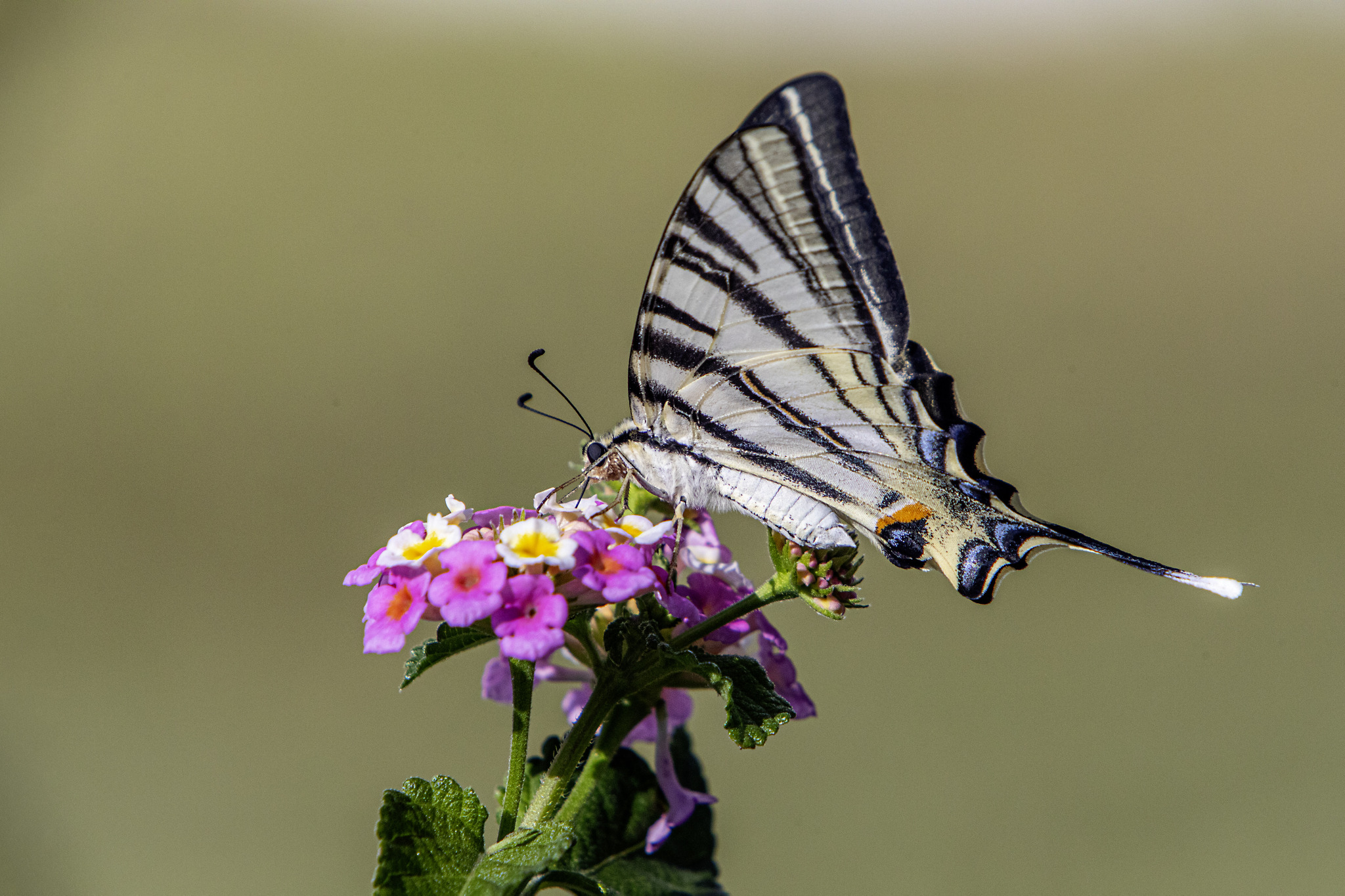The Scarce Swallowtail (Iphiclides podalirius) is a large, strikingly beautiful butterfly belonging to the family Papilionidae. Known for its distinctive wing shape and elegant color patterns, this butterfly is widely distributed across Europe, parts of North Africa, and Asia. Despite its name, the Scarce Swallowtail is not particularly rare in many parts of its range, though its populations are sensitive to habitat changes.
Physical Description:
- Wingspan: The Scarce Swallowtail has an impressive wingspan of 60 to 80 mm (about 2.4 to 3.1 inches).
- Coloration:
- Forewings: The forewings are pale yellow or cream-colored, adorned with bold black stripes that run vertically. These stripes resemble tiger markings, contributing to its alternate name, the “Sail Swallowtail.”
- Hindwings: The hindwings feature long tails typical of swallowtail butterflies. They are similarly pale with black markings and contain vibrant blue crescent-shaped spots near the base, along with a distinctive orange-red eyespot near the tails.
- Body: The body is mostly yellowish with black stripes along the thorax and abdomen, matching the pattern on the wings.
- Tail-like Extensions: The butterfly’s hindwings have elongated tails, which mimic the appearance of a swallow’s tail, giving it its name “swallowtail.”
Behavior:
- Flight: The Scarce Swallowtail is known for its graceful and strong flight. It flies in a slow, floating manner, often gliding between wingbeats, making it an elegant sight as it moves through open landscapes.
- Feeding: Adult Scarce Swallowtails feed primarily on nectar from a variety of flowering plants, favoring species like lavender, thistles, butterfly bush (Buddleia), and other brightly colored flowers.
- Territoriality: Males are often territorial, flying high in the air to patrol their chosen area and occasionally engage in aerial displays with rivals to defend their territory.
Habitat:
The Scarce Swallowtail prefers open, sunny habitats, often found in:
- Meadows and Grasslands: Especially those with abundant wildflowers, where it can easily find nectar sources.
- Orchards and Vineyards: It is often associated with areas where fruit trees and grapevines grow, particularly in Mediterranean climates.
- Hillsides and Woodland Edges: The butterfly thrives in areas with a mix of open ground and scattered trees or shrubs.
- Gardens: In more urban areas, it can be seen in gardens that have suitable flowering plants for feeding.
Distribution:
The Scarce Swallowtail is widely distributed across several regions, including:
- Europe: Found in Southern and Central Europe, from Spain and Italy to Greece, and extending as far north as parts of Germany and Poland.
- North Africa: Some populations are present in North Africa, particularly in the Mediterranean coastal regions.
- Asia: The species extends eastward into parts of the Middle East and Asia Minor.
Life Cycle and Reproduction:
- Eggs: Females lay their eggs singly on the leaves of host plants. The eggs are small, round, and pale green or yellow.
- Larvae: The caterpillars of the Scarce Swallowtail are green with light and dark stripes and small spots, which help them blend in with their host plants. The larvae primarily feed on the leaves of rosaceae species, such as:
- Prunus species (wild cherry, blackthorn)
- Crataegus (hawthorn)
- Malus (apple)
- Pyrus (pear)
- Acer (maple) in some regions.
- Pupation: The caterpillar eventually forms a green or brown chrysalis, which is attached to stems or leaves of the host plant. The chrysalis may remain in this stage for several weeks before the adult butterfly emerges.
- Generation: In warmer regions, the Scarce Swallowtail can have two generations per year, while in cooler areas, it usually has just one.
Adaptations:
- Mimicry and Camouflage: The distinctive tail extensions on the hindwings may act as a decoy, drawing predator attacks away from the butterfly’s body and vital areas. Additionally, the caterpillars are well-camouflaged to blend in with the leaves of their host plants.
- Thermoregulation: Like many butterflies, the Scarce Swallowtail uses basking behavior to regulate its body temperature. Its pale wings allow it to effectively warm up in sunlight, particularly during cool mornings.
Conservation Status:
The Scarce Swallowtail is listed as Least Concern by the IUCN, meaning it is not currently under significant threat globally. However, in certain regions, especially in parts of northern Europe, habitat loss due to agricultural expansion, pesticide use, and deforestation has led to localized declines in population. Conservation efforts focus on preserving its natural habitats, particularly wildflower meadows and traditional orchards.
Interesting Facts:
- “Scarce” Misnomer: Despite being called the “Scarce” Swallowtail, the butterfly is not particularly rare in many parts of its range. The name likely comes from its perceived rarity in specific regions or its sensitivity to habitat changes.
- Migratory Tendencies: In some areas, the Scarce Swallowtail exhibits migratory behavior, especially in southern Europe and the Mediterranean, where it may move in search of suitable feeding or breeding grounds.
- Elegant Flier: The butterfly is known for its slow, graceful flight and is often considered one of the most attractive species in Europe due to its size and distinctive markings.
Ecological Role:
The Scarce Swallowtail plays an important role as a pollinator in its ecosystems. As it feeds on nectar from various wildflowers, it helps pollinate these plants, ensuring the continuation of their life cycles. The larvae, feeding on trees and shrubs in the rose family, are part of the food web, serving as prey for birds and other insectivores.
Conclusion:
The Scarce Swallowtail (Iphiclides podalirius) is a large, charismatic butterfly admired for its striking wing patterns and graceful flight. With a wide distribution across Europe, North Africa, and parts of Asia, it thrives in sunny, open habitats, from meadows to orchards. Though it faces some challenges due to habitat loss, its adaptability to various environments ensures that it remains a prominent species in many regions. Its beauty and ecological importance make it a species of interest to both butterfly enthusiasts and conservationists alike.
Views: 1342
Subscribe to the newsletter:
